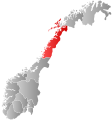Flakstad
| Flakstad kommune | |||
|---|---|---|---|
| Municipality | |||
 |
|||
|
|||
 Flakstad within Nordland |
|||
| Coordinates: 68°4′45″N 13°16′28″E / 68.07917°N 13.27444°ECoordinates: 68°4′45″N 13°16′28″E / 68.07917°N 13.27444°E | |||
| Country | Norway | ||
| County | Nordland | ||
| District | Lofoten | ||
| Administrative centre | Ramberg | ||
| Government | |||
| • Mayor (2007) | Stein Iversen (Distrikstliste) | ||
| Area | |||
| • Total | 178.14 km2 (68.78 sq mi) | ||
| • Land | 168.81 km2 (65.18 sq mi) | ||
| • Water | 9.33 km2 (3.60 sq mi) | ||
| Area rank | 345 in Norway | ||
| Population (2012) | |||
| • Total | 1,383 | ||
| • Rank | 370 in Norway | ||
| • Density | 8.2/km2 (21/sq mi) | ||
| • Change (10 years) | -10.2 % | ||
| Demonym(s) | Flakstadfjerding | ||
| Time zone | CET (UTC+1) | ||
| • Summer (DST) | CEST (UTC+2) | ||
| ISO 3166 code | NO-1859 | ||
| Official language form | Neutral | ||
| Website | www |
||
|
|
|||
Flakstad is a municipality in Nordland county, Norway. It is part of the traditional district of Lofoten. The administrative centre of the municipality is the village of Ramberg. Other villages include Fredvang and Vareid.
The municipality is located in the Lofoten Islands and comprises the island of Flakstadøya and the northern part of the island of Moskenesøya. The European route E10 highway runs across the whole municipality.
The municipality of Flakstad was established on 1 January 1838 (see formannskapsdistrikt). On 1 July 1916, the southern part of the municipality (population: 1,306) was separated to form the new municipality of Moskenes. This left Flakstad with 1,667 residents.
On 1 January 1964 during a period of municipal mergers, Moskenes (population: 2,001) and Flakstad (population: 2,067) were merged back together. This merger only lasted for twelve years. On 1 January 1976, Moskenes (population: 1,705) and Flakstad (population: 2,007) were divided once again.
The municipality (originally the parish) is named after the old Flakstad farm (Norse Flakstaðir), since the first church (Flakstad Church) was built there. Historically, the name was spelled "Flagstad". The first element could be a Norse nickname (flak meaning "reckless") or it could come from the word flag meaning "rock wall", possibly referring to the large cliff near the church site. The last element is staðir which means "homestead" or "farm".
The coat-of-arms is from modern times (1989). The arms show a white fastening device used on boats on a blue background. The fastening device was chosen as a symbol for the community's seafaring history.
...
Wikipedia


